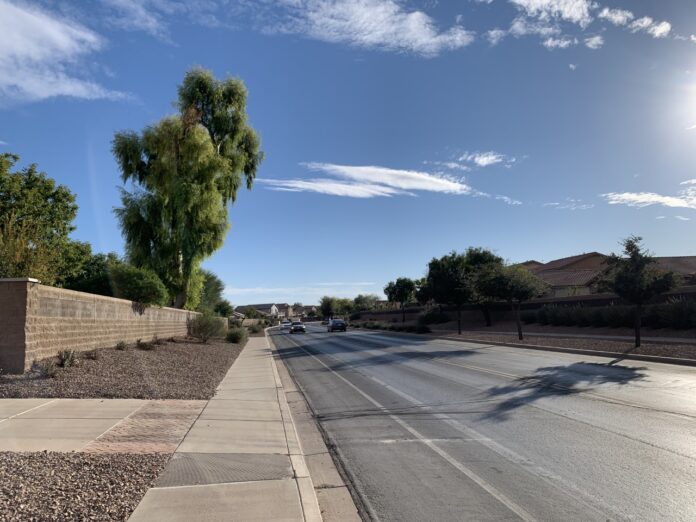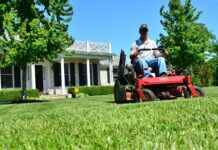
You don’t need a map or address to find the home of John and Mary Lou Smith.
From Butterfield Parkway, the oldest home in The Villages at Rancho El Dorado is given away by a landmark that seems a bit out of place.
“It’s just a plain eucalyptus,” said Mary Lou Smith — her words subduing the fascination people have with the enormous tree that has grown on her and her husband’s property for more than half a century. “It’s no fancy eucalyptus.”
Neighbors beg to differ.
Mary Lou said she’s seen people snapping photos of the gigantic, brittle structure, which rises up over the wall that hides the Smith’s home along Butterfield Parkway. The light green foliage droops off the branches like the fur of a shaggy dog, concealing the center trunk.
In a decade-old city, the elderly tree sticks out like a neon sign. The eucalyptus looks over a landscape drastically changed since the advent of the new century — a shift from farmland to house land. But at least one aspect of the view remains intact: a home that has stood just yards from the tree since its construction in the late 1950s.
Once positioned on their farm, the house — and tree — of John, 86, and Mary Lou, 83, has been engulfed by a growing bedroom community.
ucked inside the Villages neighborhood, it remains a remnant of the tiny farming community that once was.
Today, the “farmhouse” — as John Smith refers to it — is boxed in by homes and a small neighborhood park. Butterfield Parkway is the main loop around the Villages neighborhood. Their property has a gate entrance from that road positioned behind the house. Getting to the front of the home requires a bit of navigation through neighborhood streets.
Their home, and the 2.5 acres of land it sits on, is not part of the homeowners association that services their neighbors on all sides.
The couple sold their farmland to a developer under the condition they could keep their house.
“If they wanted to buy it, they bought it under those conditions,” John Smith said. “That’s all there was to it. I was not going to move.”
Building a home
The birth of the Smith residence — a household where five sons and a daughter were reared — began with the prospect of success.
John sums it up in a single word: “Opportunity.” After a slight pause, he adds: “It’s just that simple.”
John, a Glendale native who attended the University of Arizona, worked as a foreman for an Arizona cotton company before he and a partner purchased their own land in what is today the city of Maricopa.
They became cotton farmers.
Throughout the country, “cotton was king,” John said. In Pinal County, multiple cotton gins operated.
John and his college football teammate, Fred Enke, bought 320 acres where University of Arizona land is located today, just off Smith-Enke Road. The road, as one can easily conclude, is named after the two farmers. Enke, who played in the National Football League, would be gone during fall months.
In less than a decade, the farmers’ small acreage, which John said wasn’t much for back then, ballooned into several thousand acres.
Good production and good prices on cotton allowed for the expansion of the land, and the two partners eventually divided it.
“We just flipped a coin and split everything down the middle,” he said.
Mary Lou Smith said their one-story home, which today includes a living room, dining area, kitchen and several bedrooms, was built on farmland in 1957. The Smiths lived in Casa Grande prior to moving into the house.
Through a connection, the Smiths were able to hire the well-known Tucson architect Josias Joesler to design the home.
Unfortunately, Joesler died while completing the house’s plans. Mary Lou said other architects who worked with Joesler finished the design and gave the money the Smith’s paid to the Joesler family.
At the time the Smiths moved into the house, Mary Lou said they had four children and only two bedrooms. The house was designed for two extra bedrooms, which they couldn’t afford to build.
When the Smith’s only daughter — the last of their six children — was born, it was clear they needed to expand.
Despite Mary Lou’s hesitation, the Smiths converted their original carport into a new bedroom.
“A very good move because it made the house much more interesting looking,” she said.
When their daughter was in high school, the Smiths finally added two extra rooms.
Inside the house
Receiving a tour of the home today is a bit like walking through a museum. It acts as a preservation of family history. Different items around the home present a link to the past.
For example, an old, black, rosewood piano is positioned up near a wall in the living room. Mary Lou said the bulky instrument requires about four men to move it.
“That piano has been in my family since the Civil War,” she said.
Above the piano is a picture painted by Mary Lou’s grandmother. Her family was from Tennessee, and the painting reflects a Tennessean landscape with a creek dividing a wooded area.
Other paintings in the house were completed by a family friend, including one of a tree and landscape painted on the dining room wall.
The home has other treasures that can stick out to a visitor — a brick fireplace that can warm the area with a good blaze, the walls of a hallway cluttered with family photos and a grandfather clock near the front door.
Selling the house
In addition to cotton, the Smiths grew other crops on their land, including grain, alfalfa, barley, wheat and sorghum. They also planted 25,000 pecan trees that stretched out on the south side of the home.
The business of farming was a major reason the Smiths sold their farmland — the cost of growing became too expensive.
“Cotton got so bad, there was just no money to be made,” John said. “I don’t care how good you were, how hard you worked, you just couldn’t make it. Me or anybody else. You were just farming up your equity.”
John said they sold their land to El Dorado Holdings, KB Homes and Pulte Homes. But the home had to stay, and that condition was met.


![Elena Trails releases home renderings An image of one of 56 elevation renderings submitted to Maricopa's planning department for the Elena Trails subdivison. The developer plans to construct 14 different floor plans, with four elevation styles per plan. [City of Maricopa]](https://www.inmaricopa.com/wp-content/uploads/2024/04/city-041724-elena-trails-rendering-218x150.jpg)
![Affordable apartments planned near ‘Restaurant Row’ A blue square highlights the area of the proposed affordable housing development and "Restaurant Row" sitting south of city hall and the Maricopa Police Department. Preliminary architectural drawings were not yet available. [City of Maricopa]](https://www.inmaricopa.com/wp-content/uploads/2024/04/041724-affordable-housing-project-restaurant-row-218x150.jpg)




![Silk Press Xpress ready to welcome new clients Maricopa Chamber of Commerce Director Kelly Anderson and Councilmember Henry Wade smile as LaQuinta Fisher cuts the ribbon in front of her new salon, Silk Press Xpress, on April 6, 2024. [Monica D. Spencer]](https://www.inmaricopa.com/wp-content/uploads/2024/04/spencer-040624-silk-press-xpress-ribbon-cutting-web-01-218x150.jpg)



![Alleged car thief released without charges Phoenix police stop a stolen vehicle on April 20, 2024. [Facebook]](https://www.inmaricopa.com/wp-content/uploads/2024/04/IMG_5040-218x150.jpg)




